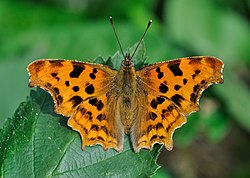| Polygonia c-album | |
|---|---|
 | |
| Dorsal view | |
 | |
| Ventral view of the hutchinsoni form showing light-coloured wing undersides | |
| Scientific classification | |
| Kingdom: | Animalia |
| Phylum: | Arthropoda |
| Class: | Insecta |
| Order: | Lepidoptera |
| Family: | Nymphalidae |
| Genus: | Polygonia |
| Species: | P. c-album |
| Binomial name | |
| Polygonia c-album | |
| Subspecies | |
Eight, see text | |
| Synonyms [1] | |
List
| |
Polygonia c-album, or the comma, is a food generalist (polyphagous) butterfly species belonging to the family Nymphalidae. The angular notches on the edges of the forewings are characteristic of the genus Polygonia , which is why species in the genus are commonly referred to as anglewing butterflies. Comma butterflies can be identified by their prominent orange and dark brown/black dorsal wings.
Contents
- Description
- Taxonomy and phylogeny
- Geographic range and habitat
- Subspecies
- Food resources
- Larval host plant preferences and selection
- Reproduction and life history
- Mating
- Oviposition
- Parent-offspring conflict
- Egg mass
- Life history
- Predators, parasites, and diseases
- Predators
- Parasites
- Diseases
- Antipredator adaptations
- Physiology
- Diapause
- Thermoregulation
- Polyphenism
- Interactions with humans
- Climate change
- Population change
- References
- Further reading
- External links
Both the larval and adult stages exhibit protective camouflage, mimicking bird droppings and fallen leaves respectively, which reduces predation. The pupae are also cryptic, resembling shriveled leaves. During the later stage of development, the larvae also develop strong spines along their backs. The species is commonly found in Europe, North Africa, and Asia, and contains several subspecies. Although the species is not migratory, the butterflies are strong fliers, resulting in an open population structure with high gene flow and increased genetic variation.











